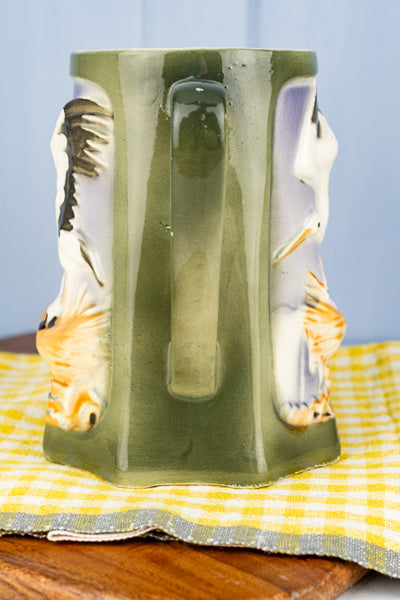Antique St. Clément Stork Pitcher
Antique St. Clément Stork Pitcher
$250.00
The Saint Clément pottery factory was founded in 1758 in the village of the same name, located in the Lorraine region of northeast France. Producing classic French faïence, the factory became known for its majolica pitchers in the form of animals. Beginning in the 1920s their production also consisted of tableware and household items of fine earthenware, in addition to their famed animal pitchers.
Found at market outside of Paris, we are delighted to present this Antique Saint Clément Stork pitcher. With a vivid raised image of a stork taking flight from a nest of baby storks, this charming pitcher is a celebration of one of nature's most beloved birds, particularly associated with the French city of Strasbourg and the Alsace region overall. Stork nests are regularly found on the roofs of houses, church bell towers and other towers in the towns and villages of Alsace. Symbolizing fidelity and fertility, storks are also thought to bring good luck to houses where they nest - just as we expect this pitcher will bring joy and luck to any home!
One-of-a-kind and subject to prior sale. In good antique condition with a few small flea bites as shown in the alternative images. 7"H x 7"D.
Learn More About St. Clément
The faience factory of Saint-Clément - about 7.5 miles from the town of Lunéville in northeastern France, was established in 1758 by Jacques Chambrette, who already owned another pottery factory in Lunéville. With this second factory he aimed at the higher segment of the market with prestigious objects that eventually earned the factory the designation as Royal Supplier for Marie-Antoinette's Trianon.
After Jacques died in 1758, his son Gabriel became the new owner. In 1892, the factory was sold to Keller et Guérin, who already owned the largest earthenware factory of Lunéville. Under their management the company was considerably expanded in the last quarter of the 19th century.
St. Clément began producing Majolica during the 1860s and continued for some forty years. St. Clément majolica is characterized by subtle shadings of colors. Majolica pieces include a series of figural animal jugs including roosters, parrots and ducks. The pottery also produced a variety of vases as well as asparagus and artichoke plates and servers. Majolica was commonly marked with the Saint Clément monogram or full name and may also include the letters ‘KG’ for Keller et Guérin.
Learn More About Majolica
First appearing in 1851 at the Great Exhibition in London, Majolica refers to the richly colored and imaginative pottery that boomed during the Victorian era. By the time it was exhibited at the 1855 Paris World's Fair, it had taken Europe and the Americas by storm, even gaining the approval of Queen Victoria herself!
While Majolica took on many whimsical and outlandish forms during its time in vogue, most designs were based on plant and animal motifs whose bright colors and textures brought a certain lighthearted charm to the rich but often dark and heavy Victorian decor. The nature-inspired designs were particularly popular among the urban-dwelling middle class, as Majolica was an affordable way to create an impressive decor and bring pastoral beauty into the home.












